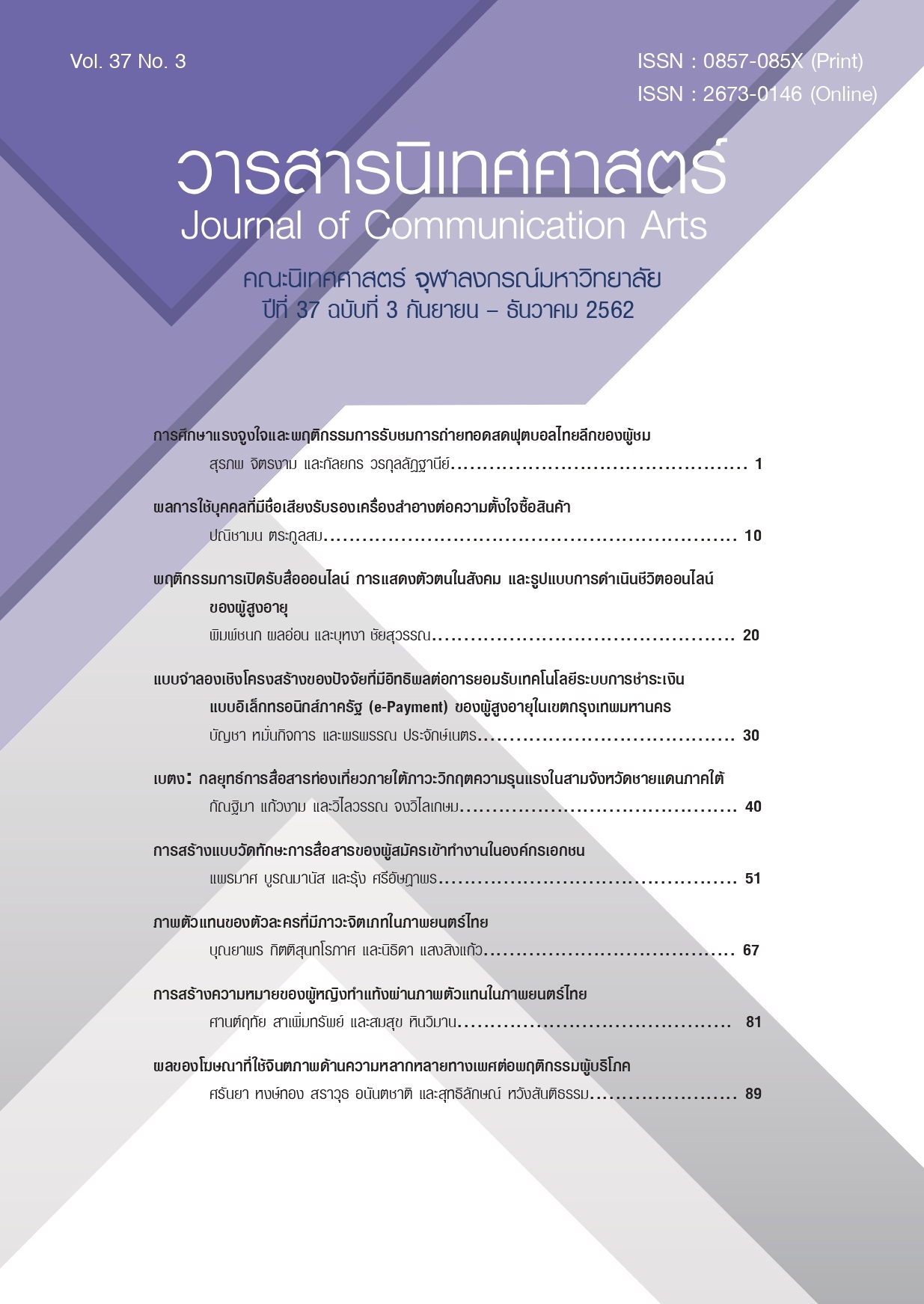Representation of People with Schizophrenia in Thai films
Main Article Content
Abstract
The purpose of this research is to study representation of people with schizophrenia in Thai films during 2008 - 2017. This qualitative research have analyze 4 Thai films; 'Memories’, ‘Meat grinder’, ‘Who are you’ and ‘Distortion’, that main character is within a scope of schizophrenia. Then, in-depth interview 8 receivers, who have direct experience with schizophrenia. The research results find that films have position people with schizophrenia in thriller or horror genre. Almost all schizophrenia characters are women in lower class, victims of violence and sexual harassment domestic. They lost control and kill someone. The conclusion of schizophrenia characters have 2 formats, die or still alive with some condition, live in mental hospital or run away. However, all character was organized into group of immedicable people. Therefore, films have the power in selection some truth about schizophrenia present to audience, such as exacerbation stage, termination or demographic, which stereotype and reproduction for a long time. Meanwhile, films emphasize that people with schizophrenia should be under control of specialist, psychiatrist or police, with cure or imprison. Otherwise, they will bring chaos to society. This is dominant discourse for control people with schizophrenia, which behind construction of schizophrenia representation in Thai films. However, direct-experience receivers understand about combination in films, reality and imagination. They use personal experience and medical knowledge as bargaining power. Furthermore, this research revealed that source of power in significance construction of schizophrenia is social institute, such as family, social, mass media, medical institute and government. Therefore, sexual discourse, family discourse, medical discourse and so on are weave in films, Because significance of schizophrenia is not construct by one power, but it’s product of social institute.
Article Details
References
กรมสุขภาพจิต. (ม.ป.ป). เกี่ยวกับเรา. วันที่เข้าถึงข้อมูล 17 มีนาคม 2561, แหล่งที่มา https://www.dmh.go.th
กาญจนา แก้วเทพ. (2541). สื่อสารมวลชน ทฤษฎี และแนวทางการศึกษา. กรุงเทพฯ: ภาพพิมพ์.
กาญจนา แก้วเทพ. (2552). การวิเคราะห์สื่อ แนวคิดและเทคนิค. กรุงเทพฯ: ภาพพิมพ์.
กาญจนา แก้วเทพ และสมสุข หินวิมาน. (2551). สายธารแห่งนักคิดทฤษฎีเศรษฐศาสตร์การเมืองกับสื่อสารศึกษา. กรุงเทพฯ: ภาพพิมพ์.
กำจร หลุยยะพงศ์. (2556). ภาพยนตร์กับการประกอบสร้างสังคม: ผู้คน ประวัติศาสตร์ และชาติ. กรุงเทพฯ: จุฬาลงกรณ์มหาวิทยาลัย.
ขจิตขวัญ กิจวิสาละ. (2553). ความหมายของการขัดขืนอำนาจของสังคมผ่านการเล่าเรื่องในภาพยนตร์ไทย ระหว่าง พ.ศ. 2513 – 2550. วิทยานิพนธ์มหาบัณฑิต สาขาวิชานิเทศศาสตร์ คณะนิเทศศาสตร์ จุฬาลงกรณ์มหาวิทยาลัย.
จิธิวดี วิไลลอย และอัศวิน เนตรโพธิ์แก้ว. (2558). การปรับแปลงความหมายผีในละครโทรทัศน์ไทย. วารสารนิเทศศาสตร์, 33(2), 47-69.
จำเริญลักษณ์ ธนะวังน้อย. (2535). บทบาทในการบันทึกสังคมของภาพยนตร์ไทย. รายงานวิจัยโครงการวิจัยเสริมหลักสูตร มหาวิทยาลัยธรรมศาสตร์.
ชโลทร โพยมยล และกิตติ กันภัย. (2554). ความรักและกระบวนการสร้างความหมายความรักในตระกูลภาพยนตร์ไทย. วารสารนิเทศศาสตร์, 29(2), 69-82.
ปิยาภรณ์ เมืองคำ. (2552). กระบวนการสร้างความหมายความพิการในภาพยนตร์อเมริกัน. วิทยานิพนธมหาบัณฑิต สาขาวิชาการสื่อสารศึกษา มหาวิทยาลัยเชียงใหม่.
ปุรินทร์ นาคสิงห์. (2556). การประกอบสร้างตัวตนเกย์ในภาพยนตร์ไทย. วารสารสังคมศาสตร์และมนุษยศาสตร์, 39(2), 35-53.
พันธุ์นภา กิตติรัตนไพบูลย์. (2549). คู่มือจิตเวชศาสตร์ สำหรับประชาชน. วันที่เข้าถึงข้อมูล 24 ตุลาคม 2560, แหล่งที่มา http://www.dmh.go.th/news/view.asp?id=1001
ภาควิชาจิตเวชศาสตร์ คณะแพทยศาสตร์โรงพยาบาลรามาธิบดี มหาวิทยาลัยมหิดล. (ม.ป.ป.). จิตเภท. วันที่เข้าถึงข้อมูล 1 ธันวาคม 2560, แหล่งที่มา https://med.mahidol.ac.th/ramamental/generaldoctor/06052015-1521
มาโนช หล่อตระกูล. (2539). จิตเวชศาสตร์ รามาธิบดี. กรุงเทพฯ: ชวนพิมพ์.
โรงพยาบาลมนารมย์. (ม.ป.ป.). โรคจิตเภท (Schizophrenia). วันที่เข้าถึงข้อมูล 20 มีนาคม 2561, แหล่งที่มา http://www.manarom.com/article-detail.php?id=93
วอยซ์ทีวี. (25 สิงหาคม 2555). พ.ร.บ.สุขภาพจิต 2551 ช่วยคนบ้ารักษาคนดี. วันที่เข้าถึงข้อมูล 20 มีนาคม 2561, แหล่งที่มา https://www.voicetv.co.th/read/48525
สัญญา สุขพณิชนันท์. (2551). ความเป็นมาของศัพท์แพทย์ภาษาไทย. เวชบันทึกศิริราช, 1(2), 91-104, วันที่เข้าถึงข้อมูล 6 กุมภาพันธ์ 2561, แหล่งที่มา https://www.tci-thaijo.org/index.php/simedbull/issue/view/7515
สุภางค์ จันทวานิช. (2559). ทฤษฎีสังคมวิทยา. กรุงเทพฯ: จุฬาลงกรณ์มหาวิทยาลัย.
สำนักงานกองทุนสนับสนุนการสร้างเสริมสุขภาพ. (2560, 23 สิงหาคม). เผยมีผู้ป่วยโรคจิตเภทเข้าถึงการรักษากว่า5 แสนคน. วันที่เข้าถึงข้อมูล 20 มีนาคม 2561, แหล่งที่มา http://www.thaihealth. or.th/Content/38316-เผยมีผู้ป่วยโรคจิตเภทเข้าถึงการรักษากว่า5แสนคน.html
ภาษาอังกฤษ
Kimmerle, J. & Cress, U. (2013). The effect of TV and film exposure on knowledge about and attitudes toward mental disorder. Journal of Community Psychology, 41(8), 931-943.
Livingston, K. (2004). Viewing popular films about mental illness through a sociological lens. Teaching Sociological, 32, 119-128.
Safran, S. P. (2001). Movie images disability and war: framing history and politicalideology. Remedial and Special Education, 22(4), 223-232.


